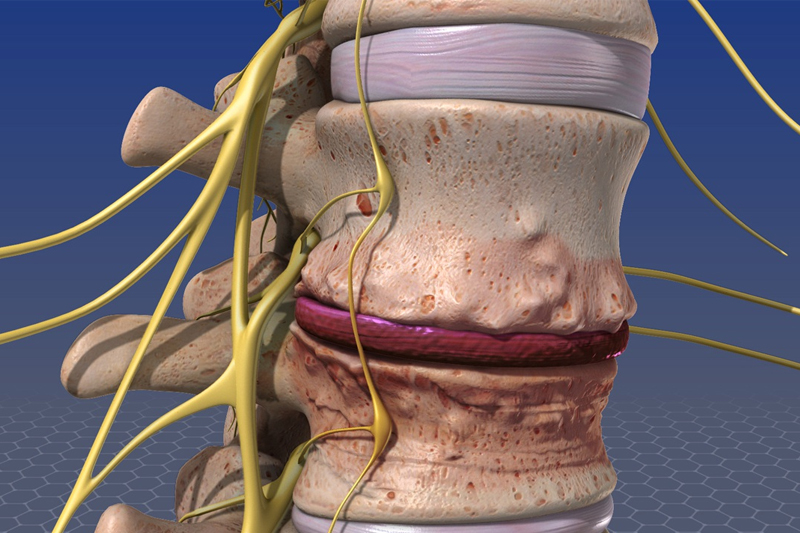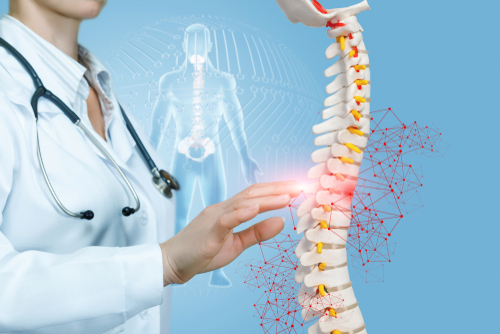The spinal discs are designed to meet the structural and dynamic needs of the spine. Discs are strong enough to manage multiple planes of motion. The disc has several functions, including serving as an integral part of the joint at each spinal motion segment.
Over time, spinal discs tend to undergo complex structural, mechanical, and chemical changes and may become a source of pain. Even slight changes of disc nutrition and motion may cause a healthy, pristine disc to begin degenerating.
Aging may make the spinal disc more rigid and flat. As the structure changes, the disc becomes more susceptible to becoming a source of pain. Most people over 60 years old will have degenerative changes in the discs, but only a very small percent of people will experience pain. This article explains the process of disc degeneration.
Spinal Disc Anatomy and Function
Each spinal disc is one part of each of the motion segments that run along the length of the spinal column. The discs act as shock absorbers between the bony vertebral bodies; the flexibility of the discs allows the spine to resist multiple planes of motion created by various types of forces.
The intervertebral disc is comprised of a series of fibrous bands that form a tough outer layer and soft material with toothpaste consistency that forms a soft inner layer.
Annulus fibrosus
The disc’s outer layer is called the annulus fibrosus, named for the fibrous tissue that composes the layer. The fibers and water content of the annulus fibrosus exist in gradients. From the outer edge moving inwards, collagen type I fiber content decreases while protein and water content increases.
Nucleus pulposus
The inner material contained in the disc is called the nucleus pulposus, named for the pulp-like or gel-like soft consistency of this layer.
Blood supply to the spinal disc
Blood vessels that supply nutrients to the disc lie in the endplates above and below it, rather than penetrating the disc itself. Low blood supply limits nutrient delivery and slows the immune system response, particularly to tissues and cells damaged by age or injury.
Nerve endings in the spinal disc
In a healthy disc structure, nerves to the disc space only penetrate into the very outer edge of the annulus fibrosus.
If a tear in the annulus fibrosus reaches the outer edge, the nerves there can become sensitized and cause significant spine pain. With continued degradation, the nerve fibers on the periphery of the disc will actually grow further into the disc space. The growth of nerves may be associated with pain from a degenerating disc.
If the nucleus pulposus, which contains a great deal of inflammatory proteins, leaks out of the disc and touches a nerve root, that nerve root can become inflamed and cause pain that radiates down a leg (sciatica or lumbar radiculopathy) or down an arm (cervical radiculopathy).
Discs degenerate in several ways over time.
- Elastin fiber content increases, especially in the inner edge of the annulus fibrosus.
- Osmotic pressure needed to maintain high water content in the nucleus decreases.
- Water content decreases, from 80% at birth to as low as 66% in the sixth decade of life.
- Disc height decreases.
High water content gives the disc its spongy quality and shock-absorbing ability. With age and degeneration, the disc gradually loses its ability to absorb shock and its flexibility.
Other characteristics of aging, dehydrating disc include:
- Yellowing of the nucleus pulposus
- Small fractures in the adjacent bones
- Thickening of the adjacent bones
- Thinning of the cartilaginous endplates
- Fewer blood vessels in the endplates
As the blood vessels that serve the disc decrease in number, the build-up of cellular waste grows. The build-up in the disc can decrease pH to as low as 6.3, making the interior of the disc more acidic and risking further cellular damage with age and with stress.
The degenerating disc can cause structural changes nearby, such as the narrowing of a nerve pathway which causes spinal stenosis and may result in radicular pain.
Degenerative Disc Disease Pain
While disc degeneration does not necessarily cause pain, research has shown that disc degeneration is strongly associated with cases of low back pain. Pain may be debilitating in nature and restrict mobility.
Disc pain may be caused by several factors acting simultaneously, usually involving nerves that penetrate deep into the disc’s outer edge or involving the instability of the disc after an injury.
- Inflammation. The proteins in the disc interior cause inflammation if they come into contact with nearby muscles, joints, and nerve roots. Inflammation can cause pain, increased muscle tension, muscle spasms, and tenderness around the affected disc, as well as sharp, shooting pains in the leg or in the arm if a nerve root is affected (sciatica, or cervical radiculopathy respectively.)
- Disc space collapse. Decreasing disc height and water content place undue strain on the joints and muscles that support the vertebrae. In some cases, a collapsed disc space can cause a nerve root to become pinched or irritated, leading to pain in the arm or leg.
- Excessive micro-motions. Decreased cushioning and support from the disc may lead to a relative increase in motion between two vertebrae. This excess motion typically causes muscle spasms and pain may irritate the joints and nerve roots and can result in the formation of bone spurs.
Pain may range from mild to severe and may become worse with certain positions, such as prolonged standing or sitting, or with certain movements, such as twisting or bending the spine. The process of how a disc degenerates has been studied and is thought to follow a typical pattern that occurs over a long period of time- several years or decades.
Dr. Ganesh mundhe is a spine specialist in pimpri chinchwad, well-known for his excellent results. He is considered among the best spine in pune. He is also among the best spine specialist in the city of pune. He is available at NRS hospital, pune which is among the best spine surgery hospital in pimpri chinchwad.
Descoperă acum magia unui cazinou românesc https://balgarskiezik.org/, cu bonusuri uimitoare și avansul de a te bucura de jocurile tale favorite în varianta demo!
Kaufen Sie die besten Luxus-Replica-Uhren bei https://replicauhrens.io und bieten Sie Replica-Uhren von Rolex, Panerai, Tag Heuer, Omega und mehr zu günstigen Preisen an.
Experience unparalleled elegance and quality at our leading online store, specializing in replica watches for men and women. Discover our range of high-end grade AAA+ 1:1 rolex replica, crafted to perfection with Swiss precision.
Acquista i migliori orologi replica di lusso su https://orologireplica.is offre orologi replica di Rolex, Panerai, Tag Heuer, Omega e altri a prezzi bassi.

